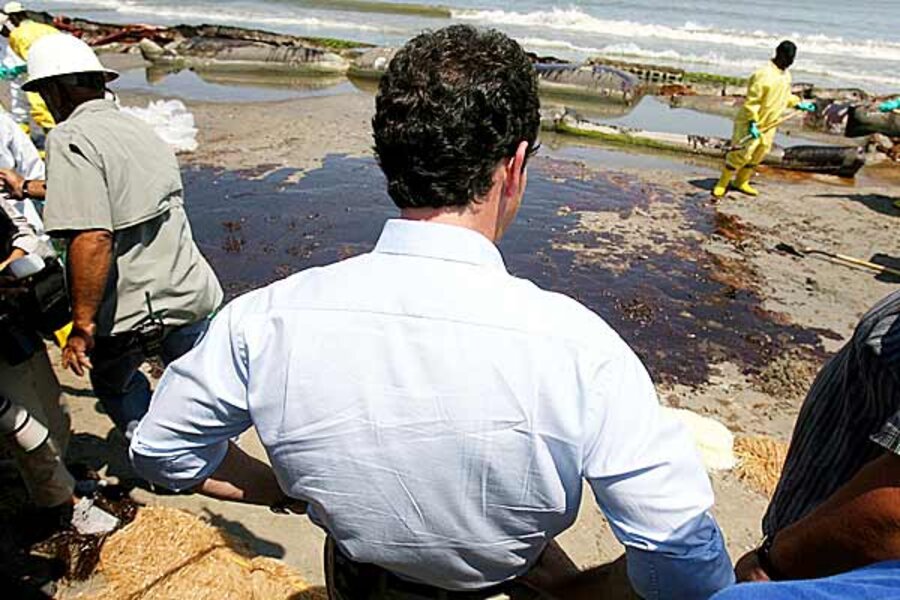EPA girds for a fight with BP over dispersants in Gulf oil spill
Loading...
The US Environmental Protection Agency (EPA) is launching an investigation into BP's assertion that there aren't any chemical dispersants better or less toxic than the product it has been using to combat the Gulf oil spill during the past month.
The Obama administration's frustration with BP over the dispersant issue has been mounting since this weekend. By Sunday, it had become clear that BP would not heed an EPA directive to find an alternative to Corexit, the dispersant that the EPA rates as less effective and more toxic than as many as 12 other products.
BP has said no such alternatives exist, either because companies cannot produce the volume BP needs on such short notice or because companies don't disclose the chemicals in their products – casting their potential environmental benefits into doubt.
Early Tuesday, the White House's energy adviser backed up that assertion about dispersants' availability. "There are not as many being manufactured as people thought in the quantities" needed, said Carol Browner, in a round of television appearances on morning news shows. "We need to determine whether or not those alternatives are available, and the EPA is doing that, but in the meantime, EPA has directed BP to use less of the dispersants and they're required to follow that."
The Obama administration has come under increasing pressure as frustrations build over the time it is taking to cap the well. Millions of gallons of oil stretch across a 150-mile swath from Dauphin Island, Ala., to Grand Isle, La., endangering wildlife and the livelihood of fishermen.
But the makers of Dispersit – a product rated by the EPA as twice as effective as Corexit and one-third less toxic – refute these claims. They said Monday that they could meet BP's demand and that the ingredients of their dispersant are public.
BP officials were not available for comment, though BP Chief Operating Officer Doug Suttles said in a press conference Monday: “We did considerable work … and found there weren’t any alternatives that were less toxic and available.”
“If we can find an alternative that is less toxic and available, we will switch to that product,” Mr. Suttles added.
EPA Administrator Lisa Jackson said Monday she “is not satisfied that BP has done enough” to explore other options. She said the EPA would launch its own investigation of how alternatives to Corexit fare in fighting oil in the Gulf.
“The science of dispersants has not in any way kept up with the science and technological ability to extract fossil fuels, and that is a huge disconnect and is one that I recommend that we remedy,” Administrator Jackson said.
In a nod to the uncertainty over the safety of Corexit, she said the federal government has told BP to scale back its use of the disperant on the surface by as much as 75 percent.
To date, BP has released 785,000 gallons of dispersant into the Gulf, with 100,000 gallons of that amount below the surface – a controversial method that some scientists have questioned. More than 340,000 gallons of Corexit remain available.
The manufacturer of Dispersit says it can readily increase production to meet the unprecedented demand. Moreover, Dispersit is a patented product so its chemical makeup is public record, which would clear up any questions regarding its effect on marine life, says Bruce Gebhardt, president of US Polychemical Corp. in Chestnut Ridge, N.Y. “Everyone has access to our information,” he adds.
Mr. Gebhardt says BP contacted him last Thursday to inquire about the product. Gebhardt says he told BP he could get supplies to the Gulf in five to seven days, but an order was never placed.
BP could not be reached to respond to Gebhardt's comments, given that all media calls are being directed to the website.
Oil is now at the Louisiana coast and is creeping to the western mouth of the Mississippi River. After a day of touring the affected region, Jackson said she is “never more convinced than now … that BP, Transocean, and Halliburton have a big job in front of them.”
Associated Press material was used in this report.
Related:





